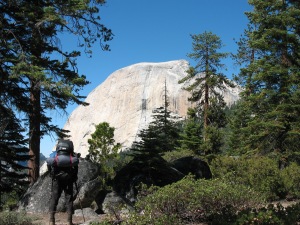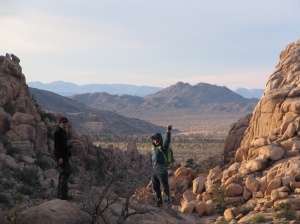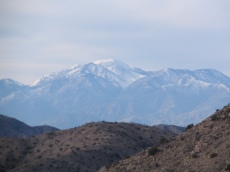
In early July 2009, my friend, co-worker, and hiking partner, Katie, set out on a 9-day trek with me through the High Sierra. It was our inaugural leg of the John Muir Trail, which stretches 221 miles from Yosemite Valley to Mount Whitney in the Southern Sierra. We are “section hikers”, backpackers who choose to tackle a long trail in shorter sections, as opposed to “thru-hikers” who do it in one go. We covered the Southernmost section, and though we covered about 55 miles of JMT, the actual trip was over 70 miles- the result of having to hike in to access the trail. In late September 2010 we tackled the northernmost section from Devils Postpile in Mammoth Lakes to Yosemite Valley. This is the only leg of the trail in which you don’t waste any time hiking to or from, so all 60 miles were JMT terrain! Once again it was a wonderful trip, though it posed many different challenges from our previous experience. I have included a day-by-day account below and a link to our photo slideshow on YouTube. I hope you enjoy reading it.
Day 1: Devils Postpile to Rosalie Lake appx. 7 miles
We left LA at 3am for the long drive to Mammoth. My father generously offered to drive us to the trailhead and pick us up in Yosemite a week later. This afforded us a prime opportunity to catch some shut-eye on the way up. In the high season, a mandatory shuttle runs from the Mammoth ski lodge to Devils Postpile, so we left Dad in the parking lot and hit the trail 30 minutes later. The Postpile is an odd basalt formation that looks a lot like matchstick-shaped rocks set up vertically. It is an interesting and impressive formation and well worth a trip if you’re in the area. But the hiking in the vicinity is the real prize in my opinion. To the West the jagged peaks of the Minarets poke out every time the view opens up, and most of the trail is a gradual uphill protected from direct sunlight by a forest that was still surprisingly green.
A short way in we met a group of several middle-aged men who were all wearing packs made by Osprey. They were a cheerful group and more than happy to let us take group photos, of both themselves and their gear. It was a lovely sunny day, and after a quick bite we shed our jackets and pressed on. Last year, we were accustomed to following water constantly, so even though Katie’s water bladder had leaked and been thrown out at Mammoth, we were confident that she would be fine with a 1-liter water bottle. For the next 4 miles, we found few water sources and the small lakes we passed all looked pretty scummy. As a result, we pushed straight to Rosalie Lake, our destination for the night. Rosalie is a beautiful spot with many good campsites, so we set up camp quickly and spent the afternoon sunning ourselves. By the time the sun went down, the wind had picked up dramatically, and we were glad we found a relatively sheltered spot. In the middle of the night, the wind was gusting so hard that it woke us up, shaking the tent and making a noise like a tidal wave breaking on top of us. We knew from the weather report that wind and a storm were likely, but the power of the wind made it very clear that whatever was coming would hit hard the next day.

Day 2: Rosalie Lake to Emerald Lake appx. 6.5 miles
In a departure from last year’s strategy, we chose to hike the shortest distances on the first two days, easing into the longer days to come. By morning of the second day, I was glad we had shifted our tactics. My right knee had been sore for a few weeks before setting off, and after the exertion of the first day, I was glad to be facing another short day. We breakfasted along with a pretty doe that took little notice of us before we packed up and set off. It was chilly and windy, so I chose to hike in my rain jacket to keep the wind off me. We climbed a small ridge before ducking into the shelter of Shadow Lake- a stunning spot from which trails branch off in multiple directions. As we climbed up toward another ridge we met a rider leading a team of pack horses whose comment was, “You’re brave, heading into the thick of it!”- which didn’t inspire much confidence. We could tell by the wind and the ominous cloud cover that something was coming. We just hoped we could gain altitude fast enough that any precip would be snow rather than rain. We were already above 9500 feet, and the trail had become much more rocky and exposed than the previous day. Despite a sense of increased vulnerability, I prefer the higher altitudes, especially between 10 and 11000 feet. The combination of exposed rock and remaining bits of vegetation feels tough, clean, and elemental.
We stopped at Garnet Lake for lunch, one of several gem-named lakes in the area, hoping its shores would provide some shelter from the wind. We were disappointed, however, and had a very cold, windblown meal. As we climbed the far side of the lake, only two miles from our intended camp at Thousand Island Lake, a large Blue Grouse and I startled each other. He was large (eatin’-chicken size, as Katie said) and injured, and could only hop along the slope a few feet from me. As we passed Ruby Lake, we met a group of hikers and pressed them for weather information. We told them where we were headed, and one of them mentioned that Thousand Island Lake was very exposed, but that there was a good campsite just before it at Emerald Lake. As it was only a half-mile from our intended camp, we opted for the sheltered spot. It proved to be a good choice. No sooner had we set up camp than the lazy snowflakes we had been getting since Ruby Lake turned into proper snow and bits of hail. We ate a quick dinner and sought refuge in the tent. In a few hours an inch or so had fallen, and we fell asleep to the sound of hail on the rain fly. That night, when I made my midnight potty run, the night was perfectly still and I could see a sky full of stars. I knew the next day was going to be a beauty.
Day 3: Emerald Lake to the North side of Donahue Pass appx. 10 miles
Katie and I woke early, knowing we had an extra half-mile to make up. Though the morning was still with a clear blue sky, the temperature was frigid. Our water had iced over and anything that used batteries was refusing to work. No wonder! The thermometer on Katie’s watch said it was 19 degrees Fahrenheit! We ate our oatmeal stomping around the campsite to keep our toes from going numb. By the time we hit the trail we were in the sunshine with high spirits. Both of us enjoyed the wildness of the weather, but were glad to have a clear day to climb the pass. When we reached Thousand Island Lake, we saw why it is such a desirable campsite. The clear blue lake is ringed by peaks to the west, with Banner Peak standing like a sentinel on the Southwest shore, and dozens of little islands dotting the water. Our informant had been correct, though. There was little shelter here and had we pressed on, we would have had a very windy night.
Once over the slight rise of Island Pass, we ducked back into the forest before starting the climb up to Donahue Pass. As we emerged from the tree cover, we could see the Sierras stretching to the South- Banner Peak, the Minarets, and even the June Mountain ski slopes near Mammoth. This was Katie’s favorite day. She loves the jagged peaks of the Southern Sierra, and as we climbed, the view just seemed to get more spectacular. By the time we reached the pass at 11000 feet, we were both feeling triumphant. Yosemite stretched to the North, and we could see the Lyell fork of the Tuolumne River that would take us all the way to the campground the next day. The pass was an obvious divide between the rugged rock of the Southern Sierra and the sweeping, pastoral beauty of Yosemite. The trail on the North side of the pass however, was much rockier with more haphazard footing than South side, and with my knee already sore, the last three miles down to our campsite were the most painful and nerve-wracking of the trip. The next morning, I broke out the knee-brace I had packed.

Day 4 North side of Donahue Pass to Tuolumne Meadows appx. 11.5 miles
We awoke to another chilly morning, but this time our water was still in liquid form. We had a pretty campsite near running water and just past a footbridge. As we set up for breakfast, Katie noticed her spork (that’s a spoon/fork combo for those who don’t remember this elementary-school cafeteria utensil) was missing. Some little critter had stolen it in the night. We searched all over, but in the end, had to eat breakfast in shifts. We dropped quickly, covering 1000 feet of elevation in a little over a mile and soon found ourselves in the Lyell valley. This area is famous among backpackers for bear incidents, but we saw nothing apart from some frolicking deer. The next 10 miles were flat as Kansas, and in some spots we pushed a pace of nearly 2.5mph. Our average last summer was just under 1.5, so we were really moving.
Our speed was also prompted by another little hitch. Katie wasn’t feeling well. She woke up not feeling her best, but by the time we hit the valley, she had a full-blown head cold. In her words, “If we’d been working today, I would have called in sick”. Instead, she pushed through the miles like a champ and tried to enjoy the sweeping views of the mountains to either side of us. We cruised into Tuolumne meadows by 2:30. There was a lot of water, and I couldn’t stop commenting on how clear it was. We set up camp in the backpacker’s campground where EVERYTHING goes in the bear locker, and headed for the general store. We purchased beer, potato chips, a spoon for Katie and Dayquil and then sat in the sun for a feast. We met a biker on his first trip to Yosemite and gave him some hiking recommendations. In return, he gave us a bottle of beer to split over dinner. We called our families, had dinner and took a stroll through the meadow. We met a ranger who was looking for a lost hiker, and with Katie feeling poorly and myself feeling sore, I was very grateful to be near people, supplies, and help.
Day 5 Tuolumne Meadows to Sunrise High Sierra Camp appx. 9 miles
The next morning Katie was feeling much better with some Dayquil in her, so we continued our trip. On the way back from the bathrooms, I heard campers banging on pots and dogs barking and knew that meant one thing: a bear. He was probably between 300 and 350 lbs. and was being shooed out of a campsite by a woman half his size. As he crossed the road, a car leaving the campground stopped short and honked their horn. The noise spooked the bear and he stood up on his back legs before jumping into a tree. In one leap his back legs were five feet off the ground. Katie had heard the noise but said the bears hadn’t been near our campsite. I think they know our food is all dehydrated!
The climb from Tuolumne Meadows to Cathedral Pass covers nearly 1300 feet of elevation, and with Katie’s breathing hindered by her cold, it was a real struggle in parts. Most of the trail winds through tree cover until you break into Cathedral Meadow with the jagged, double-spired Cathedral Peak to the East and the sweeping, graceful domes of the Yosemite high country to the North. This was my favorite view of the trip. The open meadows and sweeping lines of granite compliment each other perfectly, and the stillness of the meadow, protected by the peaks, provides the same sense of awe and stillness as the structures for which it is named. We should have refilled our water here, but observing that the trail followed a water source only a mile further, we pressed on. There had been so much water everywhere else we assumed this large creek would be running, but it was bone dry. We walked the four miles to Sunrise High Sierra Camp refilling Katie’s water bottle from my Camelbak and drinking as little as possible. We were footsore and relieved to reach the backpacker’s camp on a rocky outcrop overlooking a meadow with stunning sunset views of the Cockscomb and Matthes Crest to the East.

Day 6 Sunrise High Sierra Camp to Yosemite Valley appx 14 miles, 5700’ loss
Once again, we left the big day to the end. We rose early getting a beautiful misty sunrise and made full use of the water tap and pit toilets (they didn’t even smell!) before setting off. A brief climb took us up to 9700 feet before we started the long descent. I was anxious about the day as I was still shaken from my experience on Donahue Pass and concerned about the condition of my knee. The brace had already rubbed my skin raw on the back of my leg, but that was the least of my concerns. As it happens, the trail was well-constructed and beautifully graded, and while Katie relished the fine views, I was entirely focused on my footing. I did stop to look- you can’t help it- as western Yosemite unfolds before you. It is a remarkable feeling to look down at the top of Half Dome!
We met many hikers, several of them foreign (I got to use my high school French!), and pushed a fast pace into the valley. The steepest, most punishing part of the trail is, of course, the last two miles, but we trucked into the Happy Isles trailhead by 3pm. Unfortunately, the backpacker’s campground is at least another mile on foot, adding further distance to the 13 miles we had already done. As we feasted ourselves on another round of beer and chips in Curry Village, we seemed very apart from the crowds all around us. We were quieter, slower, and dirtier than almost everyone we saw, but I also felt that amazing calm that always stays with you for a little while after you come in from the backcountry- the stillness achieved by the absence of cars and schedules and 3G coverage. It is the pace of a world where the fastest moving object is the river or the wind, a world that is at once foreign and familiar and that disappears all to quickly when I return to the city. It leaves me each time calmer, more centered, and looking for the next adventure.
Stay Wild!
http://youtu.be/pC0D89SWZJI












